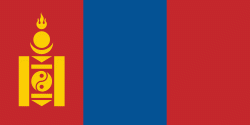Tosontsengel (Tosontsengel)
Tosontsengel (Тосонцэнгэл, meaning 'Oil happiness') is a sum of Zavkhan Province (aimag) in western Mongolia. It is the largest sum and sum centre in Zavkhan aimag after its capital, Uliastai.
Founded in 1923, Tosontsengel sum is located in the northeastern part of Zavkhan province. It is bordered by Ider, Ikh-Uul, Otgon, and Telmen sums of Zavkhan province; Tsetserleg sum of Khuvsgul province; and Tsakhir sum of Arkhangai province.
The Ider River divides Tosontsengel into two parts. The southern part of the sum is located at the head of the Tarvagatai mountain range, a branch of the Khangai Mountains, which belongs to the forest steppe and steppe zone. The main part of the Khangai Mountains occupies most of the sum.
Founded in 1923, Tosontsengel sum is located in the northeastern part of Zavkhan province. It is bordered by Ider, Ikh-Uul, Otgon, and Telmen sums of Zavkhan province; Tsetserleg sum of Khuvsgul province; and Tsakhir sum of Arkhangai province.
The Ider River divides Tosontsengel into two parts. The southern part of the sum is located at the head of the Tarvagatai mountain range, a branch of the Khangai Mountains, which belongs to the forest steppe and steppe zone. The main part of the Khangai Mountains occupies most of the sum.
Map - Tosontsengel (Tosontsengel)
Map
Country - Mongolia
 |
|
| Flag of Mongolia | |
The territory of modern-day Mongolia has been ruled by various nomadic empires, including the Xiongnu, the Xianbei, the Rouran, the First Turkic Khaganate, and others. In 1206, Genghis Khan founded the Mongol Empire, which became the largest contiguous land empire in history. His grandson Kublai Khan conquered China proper and established the Yuan dynasty. After the collapse of the Yuan, the Mongols retreated to Mongolia and resumed their earlier pattern of factional conflict, except during the era of Dayan Khan and Tumen Zasagt Khan. In the 16th century, Tibetan Buddhism spread to Mongolia, being further led by the Manchu-founded Qing dynasty, which absorbed the country in the 17th century. By the early 20th century, almost one-third of the adult male population were Buddhist monks. After the collapse of the Qing dynasty in 1911, Mongolia declared independence, and achieved actual independence from the Republic of China in 1921. Shortly thereafter, the country became a satellite state of the Soviet Union, which had aided its independence from China. In 1924, the Mongolian People's Republic was founded as a socialist state. After the anti-communist revolutions of 1989, Mongolia conducted its own peaceful democratic revolution in early 1990. This led to a multi-party system, a new constitution of 1992, and transition to a market economy.
Currency / Language
| ISO | Currency | Symbol | Significant figures |
|---|---|---|---|
| MNT | Mongolian tögrög | ₮ | 2 |
| ISO | Language |
|---|---|
| MN | Mongolian language |
| RU | Russian language |















